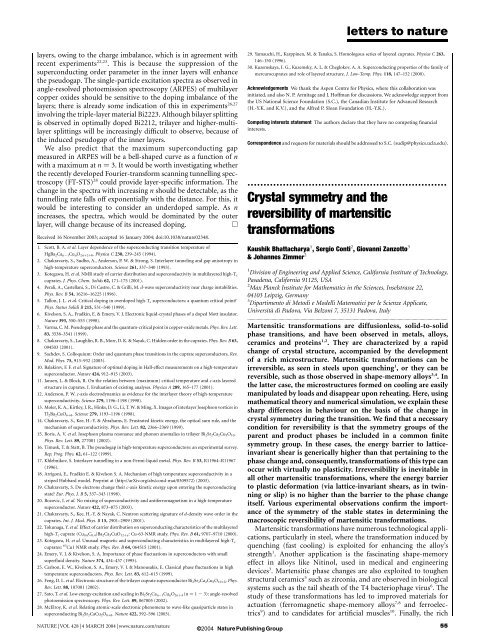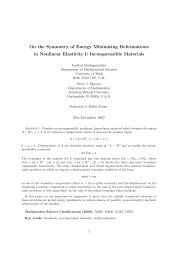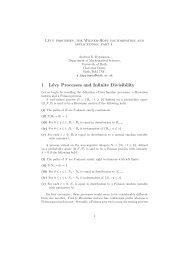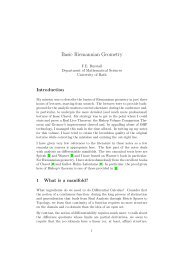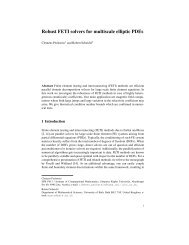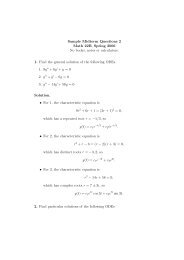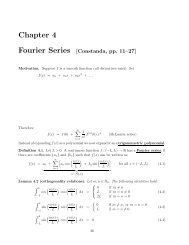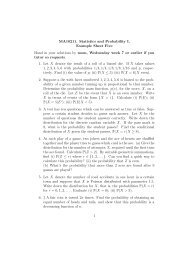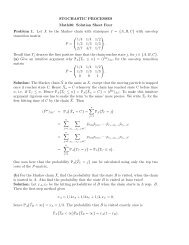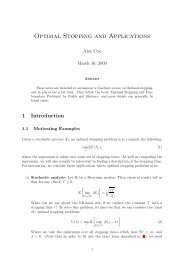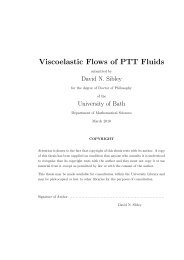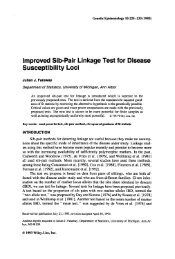Crystal symmetry and the reversibility of martensitic transformations
Crystal symmetry and the reversibility of martensitic transformations
Crystal symmetry and the reversibility of martensitic transformations
You also want an ePaper? Increase the reach of your titles
YUMPU automatically turns print PDFs into web optimized ePapers that Google loves.
letters to naturemicrostructure (distinctive patterns developed at scales rangingfrom a few nanometres to a few micrometres) that accompanies<strong>the</strong>se <strong>transformations</strong> provides a valuable test case for <strong>the</strong> development<strong>of</strong> multi-scale modelling tools 11 .In some materials, such as shape-memory alloys, <strong>the</strong> <strong>martensitic</strong>phase change is almost perfectly reversible (<strong>of</strong>ten termed ‘<strong>the</strong>rmoelastic’)3,4 . When cooling a shape-memory alloy like Nitinol fromhigh temperature, <strong>the</strong> transformation produces a microstructurewith a (twinned) plate-like morphology. This microstructure caneasily be changed by <strong>the</strong> application <strong>of</strong> loads. The transformationcan be completely reversed, with <strong>the</strong> disappearance <strong>of</strong> <strong>the</strong> microstructureupon reheating <strong>and</strong> <strong>the</strong> appearance <strong>of</strong> little or no dislocationor twinning in <strong>the</strong> parent (high temperature, high <strong>symmetry</strong>)phase.In contrast, <strong>the</strong> <strong>martensitic</strong> transformation is not reversible inmaterials like steel <strong>and</strong> o<strong>the</strong>r alloys, such as CoNi 1 . In steels, <strong>the</strong>microstructure forms in a sudden burst with a lath-like morphologyupon cooling, <strong>and</strong> is immobile on loading. Moreover, <strong>the</strong> transformationis irreversible <strong>and</strong> <strong>the</strong> microstructure does not disappearupon reheating. In CoNi <strong>the</strong> phase change is also irreversible, assuccessive microstructures form both on heating <strong>and</strong> cooling.Materials that undergo irreversible <strong>transformations</strong> are characterizedby significant dislocations <strong>and</strong> twinning in <strong>the</strong> parent phase.We provide an explanation for this difference in <strong>reversibility</strong> on<strong>the</strong> basis <strong>of</strong> <strong>the</strong> <strong>symmetry</strong> change during <strong>the</strong> transformation. Welabel as ‘weak’ <strong>the</strong> <strong>martensitic</strong> <strong>transformations</strong> in which <strong>the</strong> <strong>symmetry</strong>group <strong>of</strong> both <strong>the</strong> parent <strong>and</strong> product phase are included in acommon finite <strong>symmetry</strong> group 12 (which includes <strong>symmetry</strong> breaking),<strong>and</strong> all o<strong>the</strong>rs as ‘reconstructive’ 13 (note that this is differentfrom <strong>the</strong> usage <strong>of</strong> <strong>the</strong> term ‘reconstructive’ to mean ‘diffusional’: all<strong>the</strong> <strong>transformations</strong> considered here are diffusionless). We showthrough rigorous ma<strong>the</strong>matical <strong>the</strong>ory <strong>and</strong> numerical simulationthat ir<strong>reversibility</strong> is inevitable in a reconstructive phase transformation,but not in a weak one.Figure 1 illustrates our main idea through a square-to-hexagonalreconstructive phase change in a two-dimensional crystal. Consider<strong>the</strong> square lattice shown on <strong>the</strong> left, <strong>and</strong> suppose <strong>the</strong> solid squareunit cell is transformed to <strong>the</strong> solid unit cell <strong>of</strong> <strong>the</strong> hexagonal lattice(middle). By <strong>symmetry</strong> <strong>the</strong> solid <strong>and</strong> dashed unit cells shown in <strong>the</strong>middle are equivalent. If <strong>the</strong> crystal is transformed back to <strong>the</strong>square phase, <strong>the</strong> dashed hexagonal cell can go to, say, <strong>the</strong> dashedcell on <strong>the</strong> right. Crucially, <strong>the</strong> square cell on <strong>the</strong> left is <strong>the</strong>ntransformed to <strong>the</strong> sheared cell <strong>of</strong> <strong>the</strong> square lattice on <strong>the</strong> right.Thus, upon transforming, performing a <strong>symmetry</strong> operation, <strong>and</strong>transforming back, <strong>the</strong> crystal has undergone a lattice-invariantshear, that is, a shearing deformation that leaves <strong>the</strong> entire (ideal,Figure 1 A lattice-invariant shear can be generated by a forward <strong>and</strong> reverse square-tohexagonalphase transformation. The transformation takes <strong>the</strong> solid square on <strong>the</strong> leftto <strong>the</strong> solid rhombus in <strong>the</strong> middle. The hexagonal <strong>symmetry</strong> implies <strong>the</strong> equivalence <strong>of</strong><strong>the</strong> solid rhombic cell to <strong>the</strong> dashed rhombic one. The reverse transformation takes<strong>the</strong> latter to <strong>the</strong> dashed square on <strong>the</strong> right. In <strong>the</strong> process, <strong>the</strong> original solid square on <strong>the</strong>left has sheared by a lattice-invariant shear to <strong>the</strong> solid parallelogram on <strong>the</strong> right.infinite) lattice invariant. This also holds for finite lattices ifboundary effects can be neglected, as illustrated below by means<strong>of</strong> numerical simulations, showing dislocations <strong>and</strong> plasticdeformation.Various experimental observations confirm our predictions. Pureiron (Fe) undergoes a temperature-induced reconstructive g–a(face-centred-cubic to body-centred-cubic, f.c.c.-to-b.c.c.) transformation.As Ni <strong>and</strong> C are added to obtain steel, <strong>the</strong> martensitebecomes body-centred-tetragonal (b.c.t.) with an increasing tetragonality,so that <strong>the</strong> <strong>martensitic</strong> transformation becomes weak.Correspondingly, Maki <strong>and</strong> Tamura 14 found that with increasing Ni<strong>and</strong> C <strong>the</strong> <strong>reversibility</strong> <strong>of</strong> <strong>the</strong> phase changes increased, <strong>the</strong> amount <strong>of</strong>plastic deformation decreased, <strong>and</strong> <strong>the</strong> morphology changed fromlath to butterfly to lenticular to plate-like. Iron also undergoes apressure-induced reconstructive a–e (b.c.c. to hexagonal-closepacked,h.c.p.) transformation, again accompanied by twins <strong>and</strong>dislocations 15,16 . Ano<strong>the</strong>r set <strong>of</strong> observations concern materialsundergoing <strong>the</strong> reconstructive f.c.c.-to-h.c.p. transformation. Liuet al. 17 considered <strong>the</strong> CoNi system; <strong>the</strong>y hardened <strong>the</strong> parent phaseto prevent any plastic deformation, but found that <strong>the</strong> transformationwas still irreversible, with both heating <strong>and</strong> cooling producingtwins <strong>and</strong> plastic deformation. Similar observations were made inFeMnCrSiNi steels 18,19 . Finally, in a block co-polymer, <strong>the</strong> (reconstructive)b.c.c.-to-hexagonal transformation was observed to beirreversible because <strong>of</strong> orientation proliferation through twinningin both phases 20 .In spirit, our results are related to those <strong>of</strong> Otsuka <strong>and</strong> Shimizu 21 ,who discuss <strong>the</strong> effects <strong>of</strong> ordering on crystallographic <strong>reversibility</strong><strong>of</strong> <strong>martensitic</strong> transformation in alloys. They 21 observe that inordered alloys <strong>the</strong> transformation path must be such that <strong>the</strong>order is not destroyed, whereas in disordered ones only <strong>the</strong> atomicpositions need to be recovered. Their results are consistent withmany experiments, but <strong>the</strong>y also note that <strong>the</strong> f.c.c.-to-face-centredtetragonal(f.c.t.) transformation is an ‘exception’, which, <strong>the</strong>yargue, is a consequence <strong>of</strong> <strong>the</strong> fact that “<strong>the</strong> lattice correspondenceis unique in <strong>the</strong> reverse transformation because <strong>of</strong> <strong>the</strong> so simplelattice change <strong>and</strong> lower <strong>symmetry</strong> <strong>of</strong> <strong>the</strong> f.c.t. phase”. We show herethat <strong>the</strong> essential difference resides in <strong>the</strong> crystal <strong>symmetry</strong>, ra<strong>the</strong>rthan in order <strong>and</strong> disorder. This provides a general frameworkwhich includes both <strong>the</strong>ir 21 <strong>the</strong>ory <strong>and</strong> exception, <strong>and</strong> also extendsto o<strong>the</strong>r situations.The common explanation (in ref. 14, for example) for <strong>the</strong>ir<strong>reversibility</strong> in Fe (or low-Ni or -C steels) is based on <strong>the</strong> volumechange that accompanies <strong>the</strong> transformation. The idea is that apartially transformed region causes stress <strong>and</strong> plastic deformation.However, a system like <strong>the</strong> styrene block co-polymer <strong>of</strong> ref. 20should be largely unaffected by any volume change. Our explanationis independent <strong>of</strong> such a volume effect. It is possible,however, that both mechanisms contribute to <strong>the</strong> ir<strong>reversibility</strong> inFe.As our result is based only on <strong>the</strong> <strong>symmetry</strong> <strong>of</strong> <strong>the</strong> energeticl<strong>and</strong>scape, it is independent <strong>of</strong> material parameters, such as elasticmoduli. We show that <strong>the</strong> barrier to lattice-invariant shears inreconstructive <strong>transformations</strong> is as high as to <strong>the</strong> phase transitionitself. A remarkable implication is that reconstructive <strong>transformations</strong>are accompanied by plastic deformation through dislocations<strong>and</strong> twinning in <strong>the</strong> parent phase, making <strong>the</strong>se phase changesirreversible. In contrast, weak <strong>transformations</strong> have <strong>the</strong> potentialto be reversible, because <strong>the</strong> energy barriers to lattice-invariantshears <strong>and</strong> to <strong>the</strong> phase transition are independent <strong>of</strong> eacho<strong>the</strong>r. Our numerical simulations indicate that weak <strong>transformations</strong>are indeed generically reversible. Yet <strong>the</strong> two energy barriersmight happen to be comparable in particular materials undergoinga weak transformation. This, for example, is <strong>the</strong> case in Ni–50Ti,where plastic deformation masks <strong>the</strong> <strong>reversibility</strong>. However, (precipitate)hardening this material makes <strong>the</strong>se barriers different,<strong>the</strong>reby revealing <strong>the</strong> reversible character <strong>of</strong> <strong>the</strong> underlying weak56© 2004 Nature Publishing GroupNATURE | VOL 428 | 4 MARCH 2004 | www.nature.com/nature
letters to naturetransformation 3 . In contrast, hardening does not rescue <strong>the</strong> ir<strong>reversibility</strong><strong>of</strong> CoNi 17 or FeMnCrSiNi 18,19 , which undergo reconstructive<strong>transformations</strong>. In summary, a transformation must be weak to bereversible.Ano<strong>the</strong>r consequence <strong>of</strong> our remarks is that materials like FeNishould be comparatively s<strong>of</strong>ter at compositions that are closer to areconstructive transformation. This effect, however, may beobscured by <strong>the</strong> fact that <strong>the</strong> very s<strong>of</strong>tness <strong>of</strong> <strong>the</strong> ideal latticeproduces plastic deformation <strong>and</strong> <strong>the</strong> entanglement <strong>of</strong> dislocationsin <strong>the</strong> crystal, leading eventually to hardening. None <strong>of</strong> <strong>the</strong>sephenomena are present in crystals undergoing weak <strong>martensitic</strong><strong>transformations</strong>.We now present <strong>the</strong> general <strong>the</strong>ory followed by a concreteexample, <strong>and</strong> numerical simulations. We state <strong>the</strong> <strong>the</strong>ory for <strong>the</strong>simple case <strong>of</strong> Bravais lattices, which can readily be extended tocrystals whose translational <strong>symmetry</strong> is continuous across <strong>the</strong> phasechange. A Bravais lattice Lðe i Þ is given by <strong>the</strong> linear combinations,with integral coefficients, <strong>of</strong> three independent vectors {e 1 , e 2 , e 3 }forming <strong>the</strong> lattice basis. Ano<strong>the</strong>r basis {f 1 , f 2 , f 3 } generates <strong>the</strong>same lattice, Lðe i Þ¼Lðf i Þ; if <strong>and</strong> only if f i ¼ P 3j¼1 mj i e j with amatrix m belonging to <strong>the</strong> group 12,22,23 :G :¼ {m : m j iintegers <strong>and</strong> detðmÞ¼^1}which is <strong>the</strong> global <strong>symmetry</strong> group <strong>of</strong> Bravais lattices. Applied toany given lattice, G consists <strong>of</strong> rotations, reflections, lattice-invariantshears <strong>and</strong> combinations <strong>the</strong>re<strong>of</strong>; <strong>the</strong> restriction to rotations <strong>and</strong>reflections gives <strong>the</strong> lattice group (a matrix representation <strong>of</strong> <strong>the</strong>point group) <strong>of</strong> that lattice.The free-energy density F <strong>of</strong> <strong>the</strong> crystal is a function <strong>of</strong> <strong>the</strong> latticebasis at a fixed temperature. It is invariant under <strong>the</strong> global<strong>symmetry</strong> group G, as it cannot distinguish among bases generating<strong>the</strong> same lattice 11,23,24 :ð1ÞWe show in <strong>the</strong> Methods section that in a reconstructive transformationan unbounded element <strong>of</strong> G is always generated. Precisely,we necessarily obtain an element with an infinite period (thatis whose powers can become arbitrarily large), akin to slip <strong>and</strong>twinning in <strong>the</strong> parent phase. We note fur<strong>the</strong>r that <strong>the</strong> mostcommon reconstructive <strong>transformations</strong> involve phases with maximalpoint <strong>symmetry</strong>: <strong>the</strong> primitive-cubic, <strong>the</strong> f.c.c., <strong>the</strong> b.c.c., or <strong>the</strong>hexagonal subgroups <strong>of</strong> G. For instance, consider an f.c.c. lattice. Forsome <strong>transformations</strong> to b.c.c., such as <strong>the</strong> Bain stretch consideredbelow, <strong>the</strong> <strong>symmetry</strong> groups <strong>of</strong> <strong>the</strong> two lattices generate <strong>the</strong> entiregroup G, with its full set <strong>of</strong> lattice-invariant shears. The samehappens for any transformation between phases with maximal<strong>symmetry</strong>.The impossibility <strong>of</strong> restricting <strong>the</strong> <strong>symmetry</strong> to a finite subgroup<strong>of</strong> G, <strong>and</strong> <strong>the</strong> energy domain to a suitable EPN, has dramaticimplications for <strong>the</strong> variational treatment <strong>of</strong> reconstructive phase<strong>transformations</strong>. Indeed, if we assume that <strong>the</strong> deformation at eachtime is determined by minimizing <strong>the</strong> free-energy subject toexternal forces <strong>and</strong> boundary conditions, <strong>the</strong> invariance <strong>of</strong> <strong>the</strong>energy under <strong>the</strong> whole group G implies that <strong>the</strong> solid cannot resistany shear 27 . In practice, dynamics <strong>and</strong> defects, including dislocations,moderate this phenomenon, which we revisit through ournumerical simulations.We now focus on a concrete case study, demonstrating that <strong>the</strong>Fðe i Þ¼Fðm j i e jÞ for every m2Gð2ÞThis global framework takes all possible deformations into account,including large shearing distortions. From equation (2), <strong>the</strong> energyl<strong>and</strong>scape <strong>of</strong> <strong>the</strong> crystal has infinitely many wells, which are notcontained in any bounded region in strain space (see Fig. 2).For weak <strong>martensitic</strong> <strong>transformations</strong> <strong>the</strong> invariance <strong>of</strong> <strong>the</strong>energy (equation (2)) can be limited to a finite subgroup <strong>of</strong> Gowing to <strong>the</strong> group–subgroup relation; correspondingly, <strong>the</strong>domain <strong>of</strong> <strong>the</strong> energy can be restricted to a neighbourhood <strong>of</strong> <strong>the</strong>reference configuration. This neighbourhood does not contain anylattice-invariant shears <strong>and</strong> only contains a finite number <strong>of</strong> energywells. Such domains are called Ericksen–Pitteri neighbourhoods(EPNs) 24,25 ; see Fig. 2. Therefore, <strong>the</strong> classical framework <strong>of</strong> L<strong>and</strong>au<strong>the</strong>ory <strong>and</strong> nonlinear elasticity 11,23,26 applies in <strong>the</strong>se cases.For reconstructive <strong>martensitic</strong> <strong>transformations</strong>, on <strong>the</strong> o<strong>the</strong>rh<strong>and</strong>, <strong>the</strong> <strong>symmetry</strong> decreases along <strong>the</strong> transformation path, butincreases again at <strong>the</strong> final state, <strong>and</strong> <strong>the</strong>re is no reference configurationwhose lattice group contains those <strong>of</strong> <strong>the</strong> two given phases.We establish <strong>the</strong> following ma<strong>the</strong>matical fact: <strong>the</strong> lattice groups <strong>of</strong><strong>the</strong> two phases in any reconstructive transformation necessarilygenerate unbounded shear-like distortions. Consequently, <strong>the</strong> barrierbetween <strong>the</strong> infinitely many energy wells <strong>of</strong> <strong>the</strong> crystal is, atmost, equal to that <strong>of</strong> <strong>the</strong> underlying phase change. This implies that<strong>the</strong> material cannot resist certain arbitrarily large deformations,which makes <strong>the</strong> reconstructive transformation necessarily non<strong>the</strong>rmoelastic<strong>and</strong> irreversible, owing to <strong>the</strong> creation <strong>of</strong> defects in<strong>the</strong> lattice. At <strong>the</strong> same time, no reduction to a finite number <strong>of</strong> wellsin a bounded region is possible (no EPN can be extracted) <strong>and</strong> <strong>the</strong>classical approach <strong>of</strong> <strong>the</strong> L<strong>and</strong>au type is not applicable. (Someauthors have extended <strong>the</strong> L<strong>and</strong>au framework to encompass reconstructive<strong>transformations</strong> by introducing a “transcendental orderparameter” 13 , which gives a partial description <strong>of</strong> <strong>the</strong> lattice periodicitycharacterized by <strong>the</strong> global group G.)Figure 2 Schematic representation <strong>of</strong> weak versus reconstructive <strong>transformations</strong> in <strong>the</strong>space <strong>of</strong> lattices. a, Weak. A uniaxial deformation (dashed arrows) <strong>of</strong> <strong>the</strong> f.c.c. lattice(represented by squares) can give three equivalent b.c.t. lattices (circles). The reversetransformation (dotted arrows) returns to <strong>the</strong> original f.c.c. configuration. All <strong>the</strong>transformation strains are confined within a single EPN, such as <strong>the</strong> dashed circle.b, Reconstructive f.c.c.-to-b.c.c.. The transformation B z leads from an f.c.c. lattice tothree equivalent b.c.c. lattices, <strong>and</strong> <strong>the</strong> reverse transformation (such as V ) from eachb.c.c. lattice can proceed to three distinct but equivalent f.c.c. lattices, <strong>and</strong> so on. No EPNcan be singled out.NATURE | VOL 428 | 4 MARCH 2004 | www.nature.com/nature 57© 2004 Nature Publishing Group
phase can be observed, which accommodate <strong>the</strong> imposed boundarycondition in a reversible way (this is <strong>the</strong> origin <strong>of</strong> <strong>the</strong> memoryeffect).AMethodsTo prove that in a reconstructive transformation an aperiodic element <strong>of</strong> G (called GL(3,Z) in algebra) is generated, we first note that any lattice group is finite, <strong>and</strong> conversely anyfinite subgroup <strong>of</strong> G is included in <strong>the</strong> lattice group <strong>of</strong> some lattice (see proposition 3.5 inref. 23). Thus a transformation is weak if <strong>and</strong> only if <strong>the</strong> lattice groups <strong>of</strong> <strong>the</strong> two crystalphases generate a finite group. Therefore a reconstructive transformation produces aninfinite subgroup <strong>of</strong> G with a finite number <strong>of</strong> generators. Such a group necessarilycontains an element with no finite period as a consequence <strong>of</strong> <strong>the</strong> Burnside–Schur<strong>the</strong>orem on periodic groups.We finally establish that for any pair <strong>of</strong> Bravais lattices with maximal point <strong>symmetry</strong><strong>the</strong>re are reconstructive <strong>transformations</strong> that generate <strong>the</strong> entire group G. Indeed, it isreadily verified that for suitable pairs <strong>of</strong> subgroups in G belonging to <strong>the</strong> four arithmeticclasses with maximal point <strong>symmetry</strong> one can produce all <strong>the</strong> generators <strong>of</strong> G, that is, asuitable reflection, permutation <strong>and</strong> simple shear 30 .Received 2 September 2003; accepted 28 January 2004; doi:10.1038/nature02378.1. Olson, G. B. & Owen, W. (eds) Martensite (ASM International, Materials Park, OH, 1992).2. Salje, E. K. H. Phase Transitions in Ferroelastic <strong>and</strong> Co-elastic <strong>Crystal</strong>s (Cambridge Univ. Press,Cambridge, 1993).3. Otsuka, K. & Wayman, C. M. Shape Memory Materials (Cambridge Univ. Press, Cambridge, 1998).4. Barrett, C. S. & Massalski, T. B. Structure <strong>of</strong> Metals 3rd edn (Pergamon, Oxford, 1987).5. Bocanegra-Bernal, M. H. & De la Torre, S. D. Phase transitions in zirconium dioxide <strong>and</strong> relatedmaterials for high performance engineering ceramics. J. Mater. Sci. 37, 4947–4971 (2002).6. Olson, G. B. & Hartman, H. Martensite <strong>and</strong> life—displacive <strong>transformations</strong> as biological processes.J. Physique 43(C4), 855–865 (1982).7. James, R. D. & Wuttig, M. Magnetostriction <strong>of</strong> martensite. Phil. Mag. A 77, 1273–1299 (1998).8. Sozinov, A., Likhachev, A. A., Lanska, N. & Ullakko, K. Giant magnetic-field-induced strain inNiMnGa seven-layered <strong>martensitic</strong> phase. Appl. Phys. Lett. 80, 1746–1748 (2002).9. Shu, Y. C. & Bhattacharya, K. Domain patterns <strong>and</strong> macroscopic behaviour <strong>of</strong> ferroelectric materials.Phil. Mag. B 81, 2021–2054 (2001).10. de Gennes, P.-G. & Okumura, K. Phase transitions <strong>of</strong> nematic rubbers. Europhys. Lett. 63, 76–82(2003).11. Bhattacharya, K. Microstructure <strong>of</strong> Martensite: Why it Forms <strong>and</strong> How it Gives Rise to <strong>the</strong> Shape-Memory Effect (Oxford Univ. Press, Oxford, 2003).12. Ericksen, J. L. Weak <strong>martensitic</strong> <strong>transformations</strong> in Bravais lattices. Arch. Ration. Mech. Anal. 107,23–36 (1989).13. Tolédano, P. & Dmitriev, V. Reconstructive Phase Transitions (World Scientific, Singapore, 1996).14. Maki, T. & Tamura, I. in Proc. Int. Conf. on Martensitic Transformations 963–970 (The Japan Institute<strong>of</strong> Metals, Nara, 1986).15. Barker, L. M. & Hollenbach, R. E. Shock wave study <strong>of</strong> <strong>the</strong> a $ 1 phase transition in iron. J. Appl. Phys.45, 4872–4887 (1974).16. Kadau, K., Germann, T. C., Lomdahl, P. S. & Holian, B. L. Microscopic view <strong>of</strong> structural phasetransitions induced by shock waves. Science 296, 1681–1684 (2002).17. Liu, Y. et al. Thermomechanical behaviour <strong>of</strong> fcc $ hcp <strong>martensitic</strong> transformation in CoNi. J. AlloysCompd. (in <strong>the</strong> press).18. Matsumoto, S., Sato, A. & Mori, T. Formation <strong>of</strong> h.c.p. <strong>and</strong> f.c.c. twins in an Fe-Mn-Cr-Si-Ni alloy.Acta Metall. Mater. 42, 1207–1213 (1994).19. Yang, J. H. & Wayman, C. M. On secondary variants formed at intersections <strong>of</strong> 1 martensite variants.Acta Metall. Mater. 40, 2011–2023 (1992).20. Lee, H. H. et al. Orientational proliferation <strong>and</strong> successive twinning from <strong>the</strong>rmoreversiblehexagonal-body-centered cubic transitions. Macromolecules 35, 785–794 (2002).21. Otsuka, K. & Shimizu, K. On <strong>the</strong> crystallographic <strong>reversibility</strong> <strong>of</strong> <strong>martensitic</strong> <strong>transformations</strong>. ScriptaMet. 11, 757–760 (1977).22. Schwarzenberger, R. L. E. Classification <strong>of</strong> crystal lattices. Proc. Camb. Phil. Soc. 72, 325–349 (1972).23. Pitteri, M. & Zanzotto, G. Continuum Models for Phase Transitions <strong>and</strong> Twinning in <strong>Crystal</strong>s(Chapman & Hall/CRC, Boca Raton, 2002).24. Ericksen, J. L. Some phase transitions in crystals. Arch. Ration. Mech. Anal. 73, 99–124 (1980).25. Pitteri, M. Reconciliation <strong>of</strong> local <strong>and</strong> global symmetries <strong>of</strong> crystals. J. Elast. 14, 175–190 (1984).26. Ball, J. M. & James, R. D. Proposed experimental tests <strong>of</strong> a <strong>the</strong>ory <strong>of</strong> fine microstructure <strong>and</strong> <strong>the</strong> twowellproblem. Phil. Trans. R. Soc. Lond. A 338, 389–450 (1992).27. Fonseca, I. Variational methods for elastic crystals. Arch. Ration. Mech. Anal. 97, 189–220 (1987).28. Hull, D. & Bacon, D. J. Introduction to Dislocations 3rd edn (Pergamon, Oxford, 1984).29. Conti, S. & Zanzotto, G. A variational model for reconstructive phase <strong>transformations</strong> in crystals, <strong>and</strong><strong>the</strong>ir relation to dislocations <strong>and</strong> plasticity. Arch. Ration. Mech. Anal. (in <strong>the</strong> press).30. Hua, L. K. & Reiner, I. On <strong>the</strong> generators <strong>of</strong> <strong>the</strong> symplectic modular group. Trans. Am. Math. Soc. 65,415–426 (1949).Acknowledgements This work was largely carried out when J.Z. held a position at <strong>the</strong> CaliforniaInstitute <strong>of</strong> Technology. The work <strong>of</strong> S.C. <strong>and</strong> J.Z. was partially supported by <strong>the</strong> DeutscheForschungsgemeinschaft. G.Z. acknowledges <strong>the</strong> partial support <strong>of</strong> <strong>the</strong> Italian MIUR (CoFinModelli Matematici per i Materiali). S.C. <strong>and</strong> G.Z. acknowledge <strong>the</strong> partial support <strong>of</strong> <strong>the</strong> IVFramework Programme <strong>of</strong> <strong>the</strong> EU. K.B. <strong>and</strong> J.Z. acknowledge <strong>the</strong> partial financial support <strong>of</strong> <strong>the</strong>US Air Force Office <strong>of</strong> Scientific Research <strong>and</strong> <strong>the</strong> US Office <strong>of</strong> Naval Research. All authorscontributed equally to this work.Competing interests statement The authors declare that <strong>the</strong>y have no competing financialinterests.Correspondence <strong>and</strong> requests for materials should be addressed to K.B. (bhatta@caltech.edu).letters to nature..............................................................Polar ocean stratificationin a cold climateDaniel M. Sigman 1 , Samuel L. Jaccard 2 & Gerald H. Haug 31 Department <strong>of</strong> Geosciences, Princeton University, Princeton, New Jersey08544, USA2 Department <strong>of</strong> Earth Sciences, ETH, CH-8092 Zürich, Switzerl<strong>and</strong>3 Ge<strong>of</strong>orschungszentrum Potsdam, D-14473 Potsdam, Germany.............................................................................................................................................................................The low-latitude ocean is strongly stratified by <strong>the</strong> warmth <strong>of</strong> itssurface water. As a result, <strong>the</strong> great volume <strong>of</strong> <strong>the</strong> deep ocean haseasiest access to <strong>the</strong> atmosphere through <strong>the</strong> polar surface ocean.In <strong>the</strong> modern polar ocean during <strong>the</strong> winter, <strong>the</strong> verticaldistribution <strong>of</strong> temperature promotes overturning, with colderwater over warmer, while <strong>the</strong> salinity distribution typicallypromotes stratification, with fresher water over saltier. However,<strong>the</strong> sensitivity <strong>of</strong> seawater density to temperature is reduced astemperature approaches <strong>the</strong> freezing point, with potential consequencesfor global ocean circulation under cold climates 1,2 .Here we present deep-sea records <strong>of</strong> biogenic opal accumulation<strong>and</strong> sedimentary nitrogen isotopic composition from <strong>the</strong> SubarcticNorth Pacific Ocean <strong>and</strong> <strong>the</strong> Sou<strong>the</strong>rn Ocean. Theserecords indicate that vertical stratification increased in bothnor<strong>the</strong>rn <strong>and</strong> sou<strong>the</strong>rn high latitudes 2.7 million years ago,when Nor<strong>the</strong>rn Hemisphere glaciation intensified in associationwith global cooling during <strong>the</strong> late Pliocene epoch. We proposethat <strong>the</strong> cooling caused this increased stratification by weakening<strong>the</strong> role <strong>of</strong> temperature in polar ocean density structure so as toreduce its opposition to <strong>the</strong> stratifying effect <strong>of</strong> <strong>the</strong> verticalsalinity distribution. The shift towards stratification in <strong>the</strong>polar ocean 2.7 million years ago may have increased <strong>the</strong> quantity<strong>of</strong> carbon dioxide trapped in <strong>the</strong> abyss, amplifying <strong>the</strong> globalcooling.The Subarctic Zone in <strong>the</strong> North Pacific Ocean <strong>and</strong> <strong>the</strong> AntarcticZone in <strong>the</strong> Sou<strong>the</strong>rn Ocean are both characterized by year-roundavailability <strong>of</strong> <strong>the</strong> ‘major nutrients’ nitrate <strong>and</strong> phosphate. Nutrientrichdeep water is brought to <strong>the</strong> surface by wind-driven upwelling<strong>and</strong> density-driven overturning. Limitation <strong>of</strong> algal growth by light 3<strong>and</strong> iron 4 prevents complete consumption <strong>of</strong> <strong>the</strong> major nutrients.The Subarctic Pacific maintains a higher degree <strong>of</strong> nutrient utilization(<strong>and</strong> thus lower surface nutrient concentrations) than does<strong>the</strong> Antarctic 5 . There are two likely causes for this difference. First,<strong>the</strong> exchange between <strong>the</strong> surface <strong>and</strong> deep ocean is reduced in <strong>the</strong>Subarctic Pacific relative to <strong>the</strong> Antarctic. This is partially due to <strong>the</strong>stronger ‘halocline’, or vertical salinity gradient, in <strong>the</strong> SubarcticPacific 6 (Fig. 1). Second, atmospheric deposition supplies more ironto <strong>the</strong> Subarctic Pacific than to <strong>the</strong> Antarctic, which should allowphytoplankton to consume a larger fraction <strong>of</strong> <strong>the</strong> upwelled nitrate<strong>and</strong> phosphate 4 .Despite <strong>the</strong> differences between <strong>the</strong>se two polar ocean regions,<strong>the</strong> sediments underlying <strong>the</strong>m show a similar change during <strong>the</strong>global cooling from <strong>the</strong> relatively warm mid-Pliocene to <strong>the</strong> latePliocene, when <strong>the</strong> Earth descended into <strong>the</strong> Pleistocene cycle <strong>of</strong> iceages. In both <strong>of</strong> <strong>the</strong>se regions, upon <strong>the</strong> intensification <strong>of</strong> majorNor<strong>the</strong>rn Hemisphere glaciation 2.7 million years ago (2.7 Myr),<strong>the</strong> accumulation <strong>of</strong> biogenic opal decreased abruptly, justwhen <strong>the</strong> sedimentary evidence indicates an increase in Nor<strong>the</strong>rnHemisphere sea ice <strong>and</strong> icebergs 7,8 (Figs 1 <strong>and</strong> 2; additionalreferences in Fig. 1 legend). In <strong>the</strong> Antarctic, this shift has beeninterpreted as <strong>the</strong> result <strong>of</strong> increased sea ice cover shortening <strong>the</strong>productive season <strong>of</strong> diatoms 8,9 , whereas <strong>the</strong> Subarctic Pacificchange has been explained as <strong>the</strong> onset <strong>of</strong> permanent stratificationreducing <strong>the</strong> nutrient supply to <strong>the</strong> surface 7 . Yet <strong>the</strong> similarity in <strong>the</strong>structure <strong>and</strong> timing <strong>of</strong> <strong>the</strong>se changes invites a single explanationNATURE | VOL 428 | 4 MARCH 2004 | www.nature.com/nature 59© 2004 Nature Publishing Group


